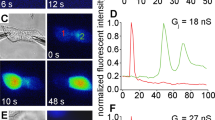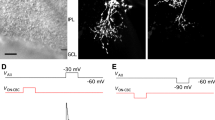Summary
Individual cells and cell pairs were isolated from frog lens epithelium. Individual cells were whole cell voltage clamped and the current-voltage relationship was determined. The cells had a mean resting voltage of −54.3 mV and a mean input resistance of 1.4 GΩ. The current-voltage relationship was linear near the cell resting voltage, but showed decreased resistance with large depolarization or hyperpolarization. Junctional currents between pairs of cells were recorded using the dual whole cell voltage-clamp technique. The corrected junctional resistance was 15.5 MΩ (64.5 nS). The junctional current-voltage relationship was linear. A combination of ATP and cAMP, in the electodes, stabilized junctional resistance. Currents recorded when uncoupling was nearly complete, showed evidence of single connexon gating events. A single-channel conductance of about 100 pS was prominent. Dye spread between isolated cell pairs was demonstrated using Lucifer Yellow CH in a whole cell configuration. Photodamage to the cells due to the dye was apparent. Dye loaded cells, in the presence of exciting light, showed decreased resting voltages, decreased input resistances and morphological changes. Glutathione (20mm) delayed this damage.
Similar content being viewed by others
References
Almers, W., Neher, E. 1985. The Ca signal from fura-2 loaded mast cells depends strongly on the method of dye-loading.FEBS Lett. 192:13–18
Bettleheim, F.A. 1985. Physical basis of lens transparency.In: The Ocular Lens, Structure, Function, and Pathology. pp. 265–300. H. Maisel, editor, Marcel Dekker, New York
Beyer, E.C., Goodenought, D.A., Paul, D.L. 1988. The connexins, a family of related gap junction proteins.In: Modern Cell Biology. E.L. Hertzberg and R.G. Johnson, editors. Vol. 7, pp. 167–176. Alan R. Liss, New York
Campos de Carvalho, A.C. 1988. Regulation of gap junctional channels.Braz. J. Med. Biol. Res. 21:177–188
Cereijido, M., Robbins, E., Sabatini, D.D., Stefani, E. 1984. Cell-to-cell communication in monolayers of epithelioid cells (MDCK) as a function of the age of the monolayer.J. Membrane Biol. 81:41–48
Cohan, C.S., Hadley, R.D., Kater, S.B. 1983. ‘Zap axotomy’: Localized fluorescent excitation of single dye-filled neurons induces growth by selective axotomy.Brain Res. 270:93–101
Colqhoun, C., Hawkes, A.G. 1977. Relaxation and fluctuation of membrane currents that flow through drug operated channels.Proc. R. Soc. Lond. 199:231–262
Cooper, K.E., Tang, J.M., Rae, J.L., Eisenberg, R.S. 1986. A cation channel in frog lens epithelia responsive to pressure and calcium.J. Membrane Biol. 93:259–269
Cota, G., Armstrong, C.M. 1988. Potassium channel “inactivation” induced by soft-glass patch pipettes.Biophys. J. 53:107–109
Dudek, F.E., Gribkoff, V.K., Olson, J.E., Hertzberg, E.L. 1988. Reduction of dye coupling in glial cultures by microinjection of antibodies against the liver gap junction polypeptide.Brain Res. 439:275–280
Duncan, G., Stewart, S., Prescott, A.R., Warn, R.M. 1988. Membrane and junctional properties of the isolated frog lens epithelium.J. Membrane Biol. 102:195–204
Furman, R.E., Tanaka, J.C. 1988. Patch electrode glass composition affects ion channel currents.Biophys. J. 53:287–292
Jack, J.J.B., Noble, D., Tsien, R.W. 1975. Electric Current Flow in Excitable Cells. Clarendon, Oxford
Jacob, T.J.C. 1984. Three types of channel activity in frog lens epithelial cells.Exp. Eye Res. 38:657–660
Jacob, T.J.C. 1988. Fresh and cultured human lens epithelial cells: An electrophysiological study of cell coupling and membrane properties.Exp. Eye Res. 47:489–506
Jacob, T.J.C., Bangham, J.A., Duncan, G. 1985. Characterization of a cation channel on the apical surface of the frog lens epithelium.Q. J. Exp. Physiol. 84:505–534
Marty, A., Neher, E. 1983. Tight-seal whole-cell recording.In: Single-Channel Recording. B. Sakmann and E. Neher, editors. pp. 107–122. Plenum, New York
Mathias, R.T. 1985. Steady-state voltages, ion fluxes, and volume regulation in syncytial tissues.Biophys. J. 48:435–448
Mathias, R.T., Rae, J.L. 1989. Cell to cell communication in the lens.In: Cell Interactions and Gap Junctions. N. Sperelakis and W.C. Coll, editors. Boca Raton (FL), CRC, (in press)
Mathias, R.T., Rae, J.L., Ebihara, L., McMarthy, R.T. 1985. The localization of transport properties in the frog lens.Biophys. J. 48:423–434
Mathias, R.T., Rae, J.L., Eisenberg, R.S. 1979. Electrical properties of structural components of the crystalline lens.Biophys. J. 25:181–201
Miller, J.P., Selverston, A.I. 1979. Rapid killing of single neurons by irradiation of intracellularly injected dye.Sciences 206:702–704
Miller, T.M., Goodenough, D.A. 1986. Evidence for two physiologically distinct gap junctions expressed by the chick lens epithelial cell.J. Cell Biol. 102:194–199
Neyton, J., Trautmann, A. 1985. Single-channel currents of an intercellular junction.Nature (London) 317:331–335
Nicholson, B.J., Takemoto, L.J., Hunkapiller, M.W., Hood, L.E., Revel, J.-P. 1983. Differences between liver gap junction protein and lens MIP26 from rat: Implications for tissue specificity of gap junctions.Cell 32:967–978
Peracchia, C. 1988. The calmodulin hypothesis for gap junction regulation six years later.In: Modern Cell Biology. E.L. Hertzberg and R.G. Johnson, editors. Vol. 7. pp. 267–284. Alan R. Liss, New York
Rae, J.L. 1984. The patch voltage clamp: Its application to lens research.Lens Res. 2:61–87
Rae, J.L. 1985. The application of patch clamp methods to ocular epithelia.Curr. Eye Res. 4:409–420
Rae, J.L., Germer, H.A. 1974. Junction potentials in the crystalline lens.J. Appl. Physiol. 37:464–467
Rae, J.L., Levis, R.A. 1984. Patch voltage clamp of lens epithelial cells: Theory and practice.Mol. Physiol. 6:115–162
Rae, J.L., Levis, R.A., Eisenberg, R.S. 1988. Ionic channels in ocular epithelia.In: Ion Channels. T. Narahashi, editor. Vol. 1, pp. 283–327. Plenum, New York
Revel, J.-P., Yancey, S.B., Nicholson, B., Hoh, J. 1986. Sequence diversity of gap junction proteins.In: Junctional Complexes of Epithelial Cells. Ciba Foundation Symposium 125. pp. 108–127. John Wiley & Sons, New York
Rojas, L., Zuazaga, C. 1988. Influence of the patch pipette glass on single acetylcholine channels recorded fromXenopus myocytes.Neurosci. Lett. 88:39–44
Safranyos, R.G.A., Caveney, S. 1985. Rates of diffusion of fluorescent molecules via cell-to-cell membrane channels in a developing tissue.J. Cell Biol. 100:736–747
Safranyos, R.G.A., Caveney, S., Miller, J.G., Petersen, N.O. 1987. Relative roles of gap junction channels and cytoplasm in cell-to-cell diffusion of fluorescent tracers.Proc. Natl. Acad. Sci. 84:2272–2276
Schuetze, S.M., Goodenough, D.A. 1982. Dye transfer between cells of the embryonic chick lens becomes less sensitive to CO2 treatment with development.J. Cell Biol. 92:694–705
Sivac, J.G. 1980. Accommodation in vertebrates: A contemporary survey.In: Current Topics in Eye Research. J.A. Zadunaisky and H. Davson, editors. Vol. 3, pp. 281–330. Academic, New York
Somogyi, R., Kolb, H.-A. 1988. Cell-to-cell channel conductance during loss of gap junctional coupling in pairs of pancreatic acinar and Chinese hamster ovary cells.Pfluegers Arch. 412:54–65
Spray, D.C., Ginzberg, R.D., Morales, E.A., Gatmaintan, Z., Arias, I.M. 1986. Electrophysiological properties of gap junctions between dissociated pairs of rat hepatocytes.J. Cell Biol. 103:135–144
Spray, D.C., Harris, A.L., Bennett, M.V.L. 1981. Equilibrium properties of a voltage-dependent junctional conductance.J. Gen. Physiol. 77:77–93
Stewart, S., Duncan, G., Marcantonio, J.M., Prescott, A.R. 1988. Membrane and communication properties of tissue cultured human lens epithelial cells.Invest. Ophthalmol. Vis. Sci. 29:1713–1725
Veenstra, R.D., DeHaan, R.L. 1986. Measurement single channel currents from cardiac gap junctions.Science 233:972–974
Wade, M.H., Trosko, J.E., Schindler, M. 1986. A fluorescence photobleaching assay of gap junction-mediated communication between human cells.Science 232:525–528
Weingart, R. 1986. Electrical properties of the nexal membrane studied in rat ventricular cell pairs.J. Physiol. (London) 370:267–284
White, R.L., Spray, D.C., Campos de Carvalho, A.C., Wittenberg, B.A., Bennett, M.V.L. 1985. Some electrical and pharmacological properties of gap junctions between adult ventricular myocytes.Am. J. Physiol. 249:C447-C455
Zampighi, G.A., Hall, J.E., Kreman, M. 1985. Purified lens junctional protein forms channels in planar lipid films.Proc. Natl. Acad. Sci. USA.82:8468–8472
Zimmerman, A.L., Rose, B. 1985. Permeability properties of cell-to-cell channels: Kinetics of fluorescent tracer diffusion through a cell junction.J. Membrane Biol. 84:269–283
Author information
Authors and Affiliations
Rights and permissions
About this article
Cite this article
Cooper, K., Rae, J.L. & Gates, P. Membrane and junctional properties of dissociated frog lens epithelial cells. J. Membrain Biol. 111, 215–227 (1989). https://doi.org/10.1007/BF01871007
Received:
Revised:
Issue Date:
DOI: https://doi.org/10.1007/BF01871007




